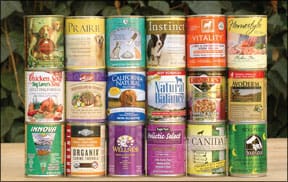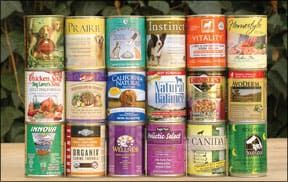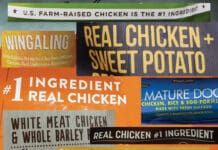We like canned food for dogs. It’s more expensive than dry, but good varieties of canned food are arguably healthier than comparable dry foods, due to the higher inclusion of animal proteins and the higher moisture levels. Both of these things are closer to the dog’s evolutionary diet than dry diets that contain a lot of grain. Some dog owners stopped buying wet dog food following the spring 2007 recalls of foods that contained melamine and/or cyanuric acid. Given the fear and lack of information in the early days of the recall, this made sense. Now, however, we know more about the factors that led to the recalls, and we feel more certain than ever that wet foods offer health benefits to many dogs – and that our recommendations for choosing wet dog foods can help owners identify the safest, healthiest products available.
Benefits
Wet foods offer your dog a few advantages over kibble:
• At levels of 70 to 80 percent moisture, canned foods are beneficial to dogs with kidney ailments.
• All that moisture can help a dog who is on a diet feel full faster – as long as you choose low-fat products. (Most wet foods are higher in fat than their kibbled counterparts.) High-moisture foods are also much healthier for dogs with kidney problems.

288
• Preservatives are not added to canned or “pouched” foods. Their oxygen-free packaging helps them retain their nutrient value longer – two years or more. Artificial colors and chemical palatants are also rarely used in wet foods.
• High-quality wet foods contain far more animal protein (the dog’s evolutionary diet staple) than dry foods (which contain a high proportion of grains and other non-meat ingredients). More of the amino acids required by dogs are naturally supplied by animal proteins than plant-sourced proteins.
• Many dogs digest high-quality wet foods with fewer problems (such as gas, vomiting, and diarrhea) than dry foods.
• Wet foods with a high meat content are generally highly palatable, which helps when feeding thin, sick, or picky dogs.
Whole Dog Journal’s selection criteria
How do we determine whether a wet food is a high-quality product? First, we look at the label. Not the front! Not the pictures, colors, cute names, or pretty logos! We look at the ingredients list for the following:
• We look for foods with whole meat, fish, or poultry as the first ingredient. This means that by weight, there is more of this ingredient than anything else in the food. Wet foods are generally around 78 percent to 82 percent moisture.
There are some good wet foods with water (or broth) first on the list, but since fresh meat is so high in moisture, most top-notch foods list an animal protein (fresh meat) first on the list, and water or broth (required for processing) in the second or third position. The point is to look for products that contain as much meat as possible. There has been a resurgence of popularity of wet foods that contain nothing but meat, water, and a vitamin/mineral supplement; many of these are labelled with a “95% meat” claim. And yes, they are complete, balanced diets. (Remember; dogs have no dietary requirement for carbohydrates!)
• If grains or vegetables are used, we look for the use of whole grains and vegetables, rather than processed fragments. This means we prefer foods that contain “rice” rather than “rice flour, rice bran, brewer’s rice,” etc. Also, if grains are used in a wet product, we sure don’t want to see a lot of them! Even a product with an animal protein first on its ingredients list may contain more grain than meat if it has several grains or grain “fragments” on the label, too.
• We reject foods containing fat or protein not identified by species. “Animal fat” and “meat proteins” are euphemisms for low-quality, low-priced mixed ingredients of uncertain origin.
• We reject any food containing meat by-products or poultry by-products. There is a wide variation in the quality and type of by-products that are available to pet food producers. And there is no way for the average dog owner (or anyone else) to find out, beyond a shadow of a doubt, whether the by-products used are carefully handled, chilled, and used fresh within a day or two of slaughter (as some companies have told us), or the cheapest, lowest-quality material found on the market.
There is some, but much less variation in the quality of whole-meat products; they are too expensive to be handled carelessly.
• We eliminate any food containing sugar or other sweetener. Again, a food that contains quality meats shouldn’t need additional palatants to entice dogs.
• We eliminate foods containing artificial colors, flavors, or added preservatives. Fortunately, these are rare in wet foods!
Other ingredients
Some ominous-sounding chemicals in a dog food turn out to be a source of a particular vitamin or mineral. Generally, all the vitamins and minerals on a good label are grouped together at the end of the ingredients list.
Wet foods sometimes contain some sort of thickener or binder. Various types of “gum” (such as guar gum, from the seed of the guar plant, and carrageenan gum, from seaweed) are common thickeners. Whole grains, potatoes, and sweet potatoes also can be used to thicken wet food. Sometimes a carb fragment serves a dual role as a thickener or binder and a low-cost source of protein; think wheat gluten. Ahem.
What about products that contain a long, long list of vegetables and herbs and nutraceuticals? They make a food sound so appealing! Just keep in mind that the more of all this stuff there is in a food, the less room there is for meat – the main reason to feed a wet food, and the main thing your dog will find delicious.
Other criteria
In 2007, we required pet food companies to disclose to us their manufacturers, for publication, in order to have their qualifying dry dog food products appear on our “top foods” lists. This is the first time we’ve asked them to disclose the makers of their wet foods – which was asking a lot, in the aftermath of the wet food recalls of spring 2007.
The last time we asked for this information, a few companies whose products had been on our “top foods” lists for years took exception. Only one was openly hostile! A couple had reasonable explanations for why they made it a policy to not disclose this information. (We discuss these in “Why We Want Disclosure; Why Some Won’t Disclose,” on the next page.) A few others simply did not respond to our requests for information. We suspect that some simply didn’t care enough to be included in our reviews to bother responding.
If you don’t see one of your favorite wet dog foods on our current list of “top wet foods”, don’t assume anything. Look for their toll-free number on the label of your dog’s food; is it there? Or not? Call them up. Did a human answer – or at least call you back within a day? If you reach a human, ask him or her a few questions about the company’s manufacturers, its ingredients, and its quality control program. This interaction (or lack thereof) will tell you a lot about the company’s commitment to quality.
Our list of “top foods”
The attcched PDF entitled “WDJ’s top wet foods of 2009” is our official list for 2009. These are all products that have met our selection criteria and answered our query about their manufacturers. There are certainly more products that both meet our criteria, as described above, and whose makers are willing to answer questions about their manufacturers. Rest assured that any food that you find that meets our selection criteria is just as good as any of the foods on our list.
What if it doesn’t meet our selection criteria? It’s up to you. If you have been feeding it to your dog, and she looks and feels like a million bucks, we’d be the last ones to tell you to switch. If she has allergies, chronic diarrhea, recurrent ear infections, or a poor coat, we’d recommend that you check out something from our list. An improvement in the quality of his food could (and probably will) work wonders.
We’ve listed the foods alphabetically, by the name of their manufacturer. If you are looking for California Natural or Evo, then, you have to look under Natura Pet Products, their maker. Some companies (like Natura) make several lines of food. We’ve listed each line and each variety that we found that meets our selection criteria. We’ve also highlighted one variety from each company as a representative product, to show what sort of ingredients and macro-nutrient levels (protein, fat, fiber, and moisture) are typically found in that maker’s foods. Be aware that some companies offer dozens of different products with varying nutrient levels and ingredients. Check the company’s website or call its toll-free phone number to get information about its other varieties.
Some companies also offer foods that are not “complete and balanced,” but are intended for “supplemental or intermittent use” only. We’ve listed some of these products, too, but only for use as described – not as a sole source of your dog’s food.
Rather than try to list all the ingredients in each food we highlight, we’ve listed the first six ingredients. Why six? No specific reason, other than that six ingredients gets you through the major contributors to the food, and gives you a good idea of what it mostly consists.
Remember, quality comes with a price. These foods may be expensive and can be difficult to find, depending on your location. Contact the company and ask about purchasing options. Some companies sell directly to consumers, or recommend mail-order outlets that will ship products.
Using the selection criteria we have outlined above, go analyze the food you are currently feeding your dog. If it doesn’t measure up, we encourage you to choose a new food based on quality, as well as what works best for you and your dog in terms of types of ingredients, levels of protein and fat, local availability, and price.






